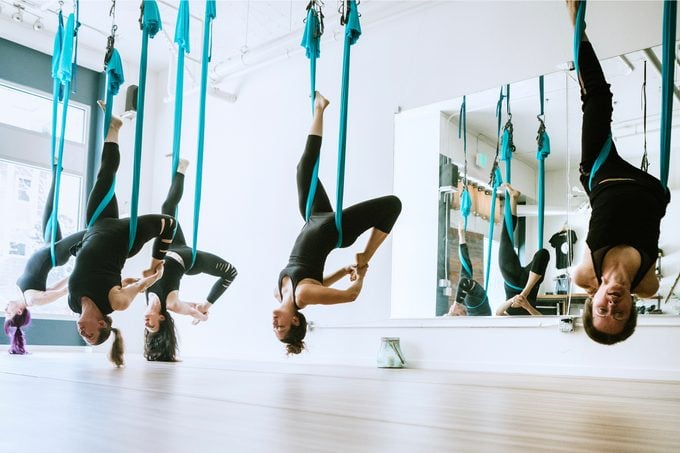Is “Fly Yoga” Worth It? Science Says It May Yield 6 Major Health Benefits
Updated: Apr. 02, 2024
What's fly yoga? Taking your asanas to the air could be a major boost to strength training and conditioning, according to instructors.

Few things stand the test of time like yoga. For thousands of years, this meditative movement modality has helped individuals practice mindfulness while keeping their muscles limber and their bones and joints healthy.
These days, scientists are continuing to discover how yoga promotes total mind-body health. Research shows us that yoga is connected with better sleep, improved digestion, and better back pain, and. According to experts from Northwestern Medicine, a regular yoga practice has even been shown to reduce the risk of heart disease, enhance lung function, and help treat stress, anxiety, and depression.
But especially if you’re a seasoned yogi who’s looking to get more from deepen your practice, aerial yoga can help take you to new heights. This modern spin on traditional flows combines classic yoga philosophies and asanas (poses) with the playful physical conditioning of aerial arts. A few different options can give your practice wings—and they’re all suitable for complete beginners and seasoned experts alike.
A Bone Health Doctor Just Listed the 12 Best Yoga Poses to Strengthen Bones
Aerial yoga
Kevin Bigger, the Teaching Training Director at Om Factory School of Yoga, says when you join your first aerial yoga class—sometimes called “fly yoga”—the first thing you’ll notice is a fabric hammock rigged above each mat, explains . “We do many of the same poses that you would find in a typical [yoga class], but some part of your body will be interacting with the hammock in some specific way,” he says. Aerial yoga brings its own flair to the ancient practice, too. Bigger says that instructors often include aerial conditioning exercises, as well as elements of Pilates, Barre, and Dance. “We also like to include cirque tricks inspired by aerial acrobatics—wind-ups, drops, and more!”
The fabric easily adjusts to your goals as well. It can work to support your body, allowing for deeper poses and alignment adjustment. That can be especially helpful for new yogis learning correct form. The hammock support can also aid in building strength and flexibility as you work toward more advanced positions, like handstands or other inversions.
No matter your level, this balancing act makes for a serious full-body workout. Bigger says that aerial yoga moves strengthen certain muscle groups more effectively than comparable “grounded” yoga classes. “Students find that almost every pose in aerial yoga requires a bit more effort from your abdominal core,” he adds.
And the physical effects go beyond great muscle toning. A small study conducted by the American Council on Exercise found that participants who practiced aerial yoga over just six weeks lowered several common heart disease risk factors, including their blood pressure, body fat percentage, and resting heart rate.
The Intriguing Link Between Your Mental Health and Heart Health
Aerial hammock
Jill Franklin, an aerialist master trainer and the founder of the global training school Aerial Physique says aerial hammock is a close cousin of aerial yoga, but with a greater emphasis on dynamic movement and creativity. “While both share similar skills, aerial hammock is more of a performance art, something you’d see in a Cirque du Soleil show,” Franklin explains. In aerial yoga, the fabric hangs around a student’s hip level for easy access to the mat. However, for an aerial hammock class, “the hammock is generally hung higher off the ground—around three to six feet—and in a way that allows for spinning,” says Hong Yu, manager at Nashville School for the Aerial Arts.
Yu says that in an introductory hammock class, you can expect to learn how to safely mount the fabric, hang upside down, and try out a few introductory poses. Like aerial yoga, “It’s a wonderful fitness activity as it relies on core stabilizers, upper body strength, and active flexibility,” she says. With more practice, students develop gymnastics-inspired skills and learn how to securely wrap, hang, and even drop in the U-shaped fabric—eventually combining tricks and transitions to create a dynamic routine.
This performance element doesn’t just add creativity and cardio to your workout, either. According to 2021 research published in Frontiers in Human Neuroscience, learning and practicing choreographed movement is associated with improved cognitive function, attention span, memory, and problem-solving skills.
Here’s How Long You Should Hold a Yoga Pose, Says a 50-Year Expert
Acroyoga
Acroyoga is another novel way to take your yoga practice higher. But instead of using an apparatus like the hammock for support, acroyoga relies on partner balancing. “It’s a practice that involves one person—the flyer—balancing and counterbalancing on a second person—the base—while progressing through a variety of poses,” Yu says. The base supports their partner while lying down, sitting, or standing. Meanwhile, the flyer maintains body tension to control their position in the air. Any acroyoga session should also involve a spotter who helps ensure both partners’ safety.
And don’t let the concept intimidate you. While having a yoga background can help newbies maintain balance, stability, and bodily awareness, no experience is necessary. Yu says that acroyoga is beginner-friendly—and as students progress, the more dynamic movements broadly tend toward acrobatics.
Just keep in mind that for any of these aerial activities, you’ll want comfortable, form-fitting activewear. Here are a few fresh leggings to shop, whether you’re on the ground or up in the air.
Get The Healthy @Reader’s Digest newsletter for wellness insights delivered on the reg. Follow us on Facebook and Instagram, and keep reading:
















